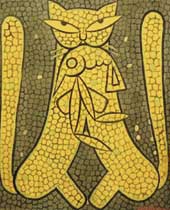 |
| A painting by Jamini Roy |
To take a trip down time is what Aakriti ? a new gallery on Hungerford Street ? invites viewers to do. On till December 31, the show has a number of Jamini Roys along with works by Gopal Ghose, Ara, Sailoz Mookherjea, Bendre and Sudhir Khastagir among others. There is also a sizeable group of paintings from a little-known artist of the 1950s, G.C. Chakraborty.
Of course, the first fear that bothers you is whether some dross may not have sneaked in under the shine of gold, considering how the smart operators of the art mart have been chasing the fast buck with fakes. However, the majority of the exhibits, we are told, have been fetched from a private collection, that of the father of the gallery owner.
Jamini Roy’s paintings ? which would be better appreciated if grouped together? recall the master’s enduring themes: cat with lobster, Jesus, man with an Indian drum and so forth. Devotees can enjoy at leisure their breathtaking linear simplicity and the raw, opaque earth colours, limited though their spectrum is.
Then there is Sailoz Mookherjea, with his flowing lines, brooding tones and nervous scratches in depicting the usual dark-skinned village woman and children. A landscape by Bendre will claim attention with its bright, stippled colours, while Gopal Ghose’s spare, abbreviated pen-and-ink sketches are quite representative of the artist’s style.
It’s rare to find Ara at art shows in the city. Here there are two by him. One is a pastel study of flowers in vases. The other, a monochrome watercolour, finds him at a common theme: exploring the nude. Kneeling on one leg, the other raised, and both arms lifted to settle the hair, the Degasesque figure is not without a balletic grace.
It seems that G.C. Chakraborty was probably self-taught. But his ease in wash technique is evident. Not surprisingly, you see the inspiration of the Bengal School and Nandalal Bose in his paintings. But the works that will intrigue viewers are monochromatic, done in a darkish grey, while the forms are more naturalistic than stylised. Often they are like illustrations to stories with a dramatic narrative content. But what is not to be missed is the artist’s deep melancholy and even, you might say, a sense of alienation in such works as Nos 191 ? with its devastated prisoner ? and 193 ? where a lone man sits by a burning candle.











